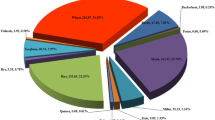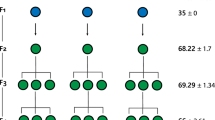Summary
Aneuploid studies in wheat often involve progenies which segregate for monosomics and disomics. In situations where only monosomics are needed, data are presented to show that their frequency can be increased by selecting wrinkled seeds for planting. Conversely, a higher proportion of disomics results from using the plumpest seeds from a cross- or self-pollination involving a monosomic parent.
Similar content being viewed by others
References
Mochizuki, A., 1968. The monosomics of durum wheat. Proc. Third Intern. Wheat Genetics Symp., Australian Acad. Sci. Canberra, Australia, August 5–9, 1968, p. 310–315.
Morris, R. &Sears, E. R., 1967. The cytogenetics of wheat and its relatives. In: K. S. Quisenberry and L. P. Reitz (Editors): Wheat and wheat improvement. Monograph 13, Am. Soc. Agronomy, Madison, Wisconsin.
Author information
Authors and Affiliations
Additional information
Published with the approval of the Director as Paper No. 2712, Journal Series, Nebraska Agric. Expt. Station.
Rights and permissions
About this article
Cite this article
Morris, R., Schmidt, J.W. & Johnson, V.A. Advantages of seed selection in wheat aneuploid studies. Euphytica 19, 194–198 (1970). https://doi.org/10.1007/BF01902945
Received:
Issue Date:
DOI: https://doi.org/10.1007/BF01902945




